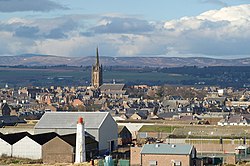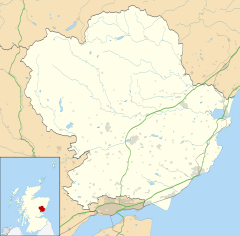Montrose
| |
|---|---|
Town and former Royal burgh | |
 View of Montrose from Ferryden | |
| Etymology: The moor by the wood (from Scottish Gaelic) | |
| Motto(s): Mare ditat, rosa decorat (Latin) The sea enriches, the rose adorns | |
Location within Angus | |
| Coordinates: 56°42′29″N 2°28′01″W / 56.708°N 2.467°W | |
| Sovereign State | |
| Country | |
| Local authority | |
| Lieutenancy area | Angus |
| First settled | Neolithic period |
| Royal Charter | 1140 |
| Royal burgh abolished | 1975 |
| Government | |
| • Councillors | List
|
| • MSPs | List
|
| • MPs | List
|
| Population (2022)[1] | |
| • Town | 11,730 |
| • Language(s) | English Scots |
| Demonym(s) | Montrosian Gable Ender |
| Postcode | |
| Area code | 01674 |
| OS Grid Reference | NO715575 |
Montrose (/mʌnˈtroʊz/ mun-TROHZ; Scottish Gaelic: Mon Rois [mɔn ˈrˠɔʃ]) is a town and former royal burgh in Angus, Scotland. Situated 28 miles (45 kilometres) north of Dundee and 37 miles (60 kilometres) south of Aberdeen, Montrose lies between the mouths of the North and South Esk rivers. It is the northernmost coastal town in Angus and developed as a natural harbour that traded in skins, hides, and cured salmon in medieval times.
With a population of approximately 12,000, the town functions as a port, but the major employer is GlaxoSmithKline, which was saved from closure in 2006.[2] The skyline of Montrose is dominated by the 220-foot (67 m) steeple of Old and St Andrew's Church, designed by James Gillespie Graham and built between 1832 and 1834.
Montrose is a town with a wealth of architecture, and is a centre for international trade. It is an important commercial port for the oil and gas industry. It is known for its wide thoroughfare and high street,[3] which leads to picturesque closes containing secluded gardens. The town has a view of a tidal lagoon, Montrose Basin, which is considered a nature reserve of international importance. It is the largest inland salt water basin in the UK, and an important habitat for the mute swan. Just outside Montrose is the 18th-century House of Dun, designed by the Scottish architect William Adam and built in 1730 for David Erskine, Lord Dun, 13th Laird of Dun.
- ^ "Mid-2020 Population Estimates for Settlements and Localities in Scotland". National Records of Scotland. 31 March 2022. Retrieved 31 March 2022.
- ^ "GlaxoSmithKline - Montrose Plant". www.contractorsunlimited.co.uk. Retrieved 3 April 2018.
- ^ "Montrose High Street". Archived from the original on 11 April 2009.




